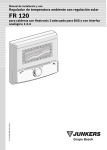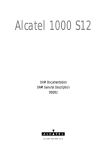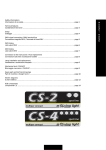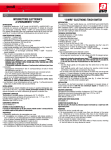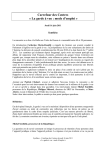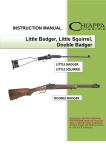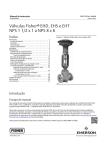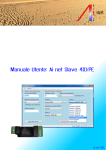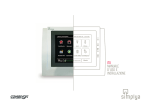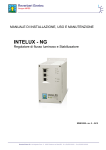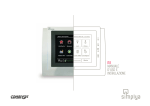Download Caratteristiche tecniche manuale C0637rev00 Carta uso mano
Transcript
Caratteristiche tecniche manuale C0637rev00 Carta uso mano 70-80 g/m2 Libretto formato aperto : 290x100 mm Formato chiuso : 145x100 mm Libretto 58 facciate. Stampa 4+4 colori. Rilegatura centrale con punto metallico. Testo secondo file grafico C0637rev00 Istruzioni per l’uso Tastiera multi touch a sfioramento Installazione "a scomparsa" 1 442TC16 Operating instructions Multi Touch Keyboard "Hidden" Installation 442TC16 29 INDICE INTRODUZIONE..........................................2 CARATTERISTICHE TECNICHE ...............2 PROGRAMMAZIONE..................................4 1 Pulsante di Programmazione ......................4 1.1Programmazione..........................................4 1.1.1 Zone sensibili...............................................5 1.1.2 Comando Tapparelle...................................7 1.1.3Monostabile/Bistabile...................................8 1.1.4 Impostazione temporizzazione..................10 1.1.5 Funzionalità avanzate: luminosità, pulizia placca, sensibilità............................14 1.2 USCITE......................................................16 1.2.1 Abbinamento zone sensibili / uscite...........16 1.3Esempi.......................................................17 1.4INGRESSI..................................................18 1.4.1 Abbinamento zone sensibili / ingressi........19 1.4.2 Autoesclusione ingressi.............................20 PULIZIA PLACCA......................................21 ITALIANO 1 CONDIZIONI CLIMATICHE.......................21 CONFORMITA' NORMATIVA....................21 2 SCHEMI DI COLLEGAMENTO.................22 2.1 Sei uscite ON/OFF, comando passo-passo...............................................22 2.2 Due Uscite tapparella (comando ad un pulsante) + 2 uscite ON/OFF................23 2.3 Tre Uscite uscite ON/OFF.........................24 2.4 Tre Uscite uscite ON/OFF.........................25 2.5 Tre Uscite tapparella (comando a due pulsanti)..............................................26 2.6 Tre Uscite tapparella (comando a due pulsanti)..............................................27 2.7 Sei Uscite ON/OFF, comando monostabile................................................28 INTRODUZIONE La tastiera multi touch con uscita a 6 relè con contatti liberi da potenziale cod. 442TC16 è un comando con sensori a sfioramento incorporato. Può essere comandata oltre che localmente anche da più punti con pulsanti NA. Permette la selezione del modo di funzionamento monostabile, monostabile temporizzato, bistabile, interbloccato per comando tapparelle sia temporizzato che “ad uomo presente”. E’ munita di led per l’individuazione dei comandi al buio e va installata “a scomparsa” sul retro di placche di finitura CARATTERISTICHE TECNICHE •Ingombro: 3 moduli “a scomparsa” S44 - profondità ridotta (29 mm; con morsettiera ingressi: 40 mm) •Grado di protezione: IP40 •Morsettiere accessibili sul lato posteriore: -7 morsetti estraibile (uscite) - 6 morsetti estraibile (ingressi) - 2 morsetti estraibile (alimentazione) Nota: la capacità dei morsetti non consente collegamenti di ripartenza (repiquage) •Tensione alimentazione: 100÷240 Vca 50-60 Hz •Campo tensione di alimentazione: da 90 Vca a 253 Vca •Assorbimento in stand-by (nessun relè eccitato): 3,5 mA a 240 Vca (0,2 W); 4 mA a 100 Vca (0,1 W) •Assorbimento massimo (tutti i relè eccitati): 13 mA a 240 Vca (1,4 W); 29 mA a 100 Vca (1,7 W) •Area frontale sensibile: l’area frontale è suddivisa in 9 zone sensibili. In fase di programmazione è possibile scegliere quali zone attivare (da un minimo di tre ad un massimo di sei) e quali funzioni assegnare a ciascuna (vedi paragrafo PROGRAMMAZIONE) •Uscita a relè: 6 contatti in chiusura collegati al comune (morsetto C). Contatto con isolamento doppio rispetto all'alimentazione (può essere utilizzato anche in circuiti SELV) •Tipo di carico comandabile in corrente alternata: - carico ohmico (cosϕ 1): 2 A a 250 Vca - 5 A a 30 Vcc - carico incandescente: 2 A a 250 Vca - carico induttivo (cosϕ 0,4): 1 A a 250 Vca - carico motore: 2A a 250 Vca 2 ITALIANO - carico fluorescente rifasato: 1A a 250 Vca - carico trasformatore ferromagnetico: 1A a 250 Vca - carico trasformatore elettronico: 1A a 250 Vca Nota: la somma delle correnti di tutti i carichi (morsetto C) deve essere massimo 10A. •Comandi: - appoggiando lievemente il dito sulla placca in corrispondenza delle zone sensibili individuabili dal led blu sul fronte del dispositivo (vedi paragrafo PROGRAMMAZIONE) - da più punti mediante pulsanti a sfioramento per comando remoto (cod. 442TC05) oppure pulsanti NA non luminosi collegati alla fase •Memoria di stato: i canali del dispositivo programmati con funzione bistabile sono dotati di memoria di stato che garantisce la memorizzazione dello stato del relè d’uscita in caso di interruzione dell'alimentazione •Led frontali colore blu per individuazione al buio: all’avvicinamento della mano il led emette una luce più intensa Note:1) il numero di segnalazioni e la loro posizione dipendono dalla scelta delle zone sensibili (vedi paragrafo PROGRAMMAZIONE) 2) nel caso in cui la luce emessa dal led risulti essere fastidiosa, è possibile ridurre la luminosità dei led (vedi paragrafo PROGRAMMAZIONE) oppure applicare sul fronte del dispositivo (retro placca) l’etichetta di colore blu ricavabile dal set cod. ETI16 •Segnalazione acustica di ingresso/uscita dallo stato di inibizione temporanea • Possibilità impostazione funzionamento uscita: monostabile, monostabile temporizzato, bistabile, interbloccato per comando tapparelle sia temporizzato che “ad uomo presente” (vedi paragrafo PROGRAMMAZIONE) •Possibilità impostazione sensibilità funzionamento del dispositivo: al tocco della placca o a 4 mm di distanza dalla placca stessa (vedi paragrafo PROGRAMMAZIONE) •Possibilità impostazione luminosità dei led blu da un valore massimo (default) allineato a quella degli altri dispositivi Touch, ad un valore minimo appena visibile al buio (vedi paragrafo PROGRAMMAZIONE) •Funzione di inibizione temporanea (escludibile) per consentire la pulizia della placca (vedi paragrafo PULIZIA PLACCA) ITALIANO 3 PROGRAMMAZIONE 1 Pulsante di programmazione Il pulsante P1 consente la programmazione del dispositivo ed è accessibile con cacciavite a taglio attraverso la fessura appositamente predisposta sul lato del dispositivo stesso (vedi Fig. 1). Fig 1 1.1 Programmazione L’accesso alla programmazione avviene premendo il pulsante laterale P1 per 4 secondi. La conferma dello stato di programmazione viene data dal buzzer e dall’accensione ciclica “circolare” in senso orario dei led rossi perimetrali per 5 secondi. La sequenza di programmazione si sviluppa su 5 passi, che di seguito vengono descritti nell’ordine in cui sono proposti. Il buzzer interno, per conferma, emette un numero di “beep” corrispondente al numero del passo di programmazione. E’ possibile passare da un passo al successivo con una breve pressione di P1. L’uscita dalla programmazione avviene premendo nuovamente il pulsante laterale P1 per 4 secondi, oppure per time-out dopo 2 minuti. 4 ITALIANO 1.1.1 Zone sensibili Il frontale del dispositivo è suddiviso in nove zone sensibili, suddivise in tre colonne da tre zone. Per ogni colonna può essere attivata o la zona centrale (2) o le due zone in alto e in basso (1 e 3) (vedi Fig. 2a, 2b, 2c). Si potranno quindi avere da un minimo di tre zone sensibili attive ad un massimo di sei (condizione di default). A 1 B 1 C 1 2 2 2 3 3 3 A Fig. 2a B C A Fig. 2b B C Fig. 2c La scelta va fatta in sequenza per ogni colonna: all’inizio viene proposta la colonna A (a sinistra) con la situazione esistente, in cui la zona attiva o inattiva è evidenziata dall’accensione del corrispondente led, rispettivamente in colore rosso (attiva) o blu (inattiva) (vedi Fig. 3a). Sfiorando la zona inattiva la situazione si inverte (vedi Fig. 3b). A ITALIANO B C Fig. 3a 5 Fig. 3b Trascorsi 3 secondi dall’ultimo tocco (o 5 secondi in assenza di tocco), vengono riproposte nello stesso modo le colonne B (centrale) (vedi Fig. 4a) e C (destra) (vedi Fig. 4b). B C Fig. 4a Fig. 4b Trascorsi 3 secondi (o 5 secondi in assenza di tocco)z dalla scelta per la colonna 3, viene presentato il riassunto delle scelte fatte: i soli led delle zone prescelte lampeggeranno rosso per tre volte (vedi Fig. 5a), ed un “beep” ripetuto del buzzer segnalerà la fine del primo passo della procedura di programmazione. Vengono poi spenti i led blu delle zone inattive (vedi Fig. 5b). Fig. 5a Fig. 5b 6 ITALIANO 1.1.2 Comando tapparelle La suddivisione delle zone sensibili in tre colonne, vista al paragrafo precedente, è propedeutica al secondo passo di programmazione, che consente di scegliere quali delle zone sono eventualmente previste per il comando di tapparelle. E’ possibile sia il comando ad un solo pulsante Touch (sempre e solo in posizione centrale) con funzione Su/Stop/Giù, sia a due pulsanti funzionalmente interbloccati (in alto ed in basso) con funzione rispettivamente Su/Stop e Giù/Stop. Anche in questo caso la programmazione viene fatta in sequenza per ogni colonna: viene acceso il led della zona attiva per ogni colonna, di colore blu se non è associato il funzionamento tapparella, di colore rosso se è invece già attivo; sfiorando la zona inattiva la situazione si inverte (vedi Fig. 6a, 6b e 7c). Fig. 6a Fig. 6b Trascorsi 3 secondi dall’ultimo tocco, vengono riproposte nello stesso modo le colonne 2 (centrale) (vedi Fig. 7a) e 3 (destra) (vedi Fig. 7b); attendendo 5 secondi si passa alla colonna successiva, senza variazioni. Fig. 7a ITALIANO Fig. 7b 7 Fig. 7c Trascorsi 3 secondi dalla scelta per la colonna 3, viene presentato il riassunto delle scelte fatte: i soli led delle zone prescelte lampeggeranno rosso per tre volte (vedi Fig. 8a), ed un “beep” ripetuto del buzzer segnalerà la fine del secondo passo della procedura di programmazione. Vengono poi spenti i led blu delle zone non scelte (vedi Fig. 8b). Nota: nell’esempio qui di seguito, le colonne 1 e 3 sono state scelte come zone con modalità tapparella. Fig. 8a Fig. 8b 1.1.3 Monostabile / bistabile Per comandi di tipo ON/OFF (non tapparella) è possibile scegliere se la modalità di funzionamento deve essere monostabile o bistabile (passo/passo). Anche in questo caso la programmazione viene fatta in sequenza per ogni colonna: viene acceso il led della zona attiva per ogni colonna che non sia già stata scelta per la modalità tapparella, di colore blu se in modalità bistabile, di colore rosso se in modalità monostabile (default). Sfiorando la zona la situazione si inverte (vedi Fig. 9a e 9b). 8 ITALIANO Nell’esempio qui di seguito, poiché le colonne 1 e 3 erano state scelte come zone con modalità tapparella (vedi paragrafo precedente), la sequenza inizia con la colonna 2. Fig. 9a Fig. 9b Trascorsi 3 secondi, viene presentato il riassunto delle scelte fatte: i soli led delle zone prescelte per funzionamento monostabile lampeggeranno rosso per tre volte (vedi Fig. 10a), ed un “beep” ripetuto del buzzer segnalerà la fine del terzo passo della procedura di programmazione. Vengono poi spenti i led blu (vedi Fig. 10b). ITALIANO Fig. 10a 9 Fig. 10b 1.1.4. Impostazione temporizzazione Tutti i comandi, monostabili o tapparella, sono di default non temporizzati, ovvero il rispettivo relè di uscita si diseccita all’allontanamento del dito dalla relativa zona sensibile (vedi Fig. 11a e 11b). B3 Relè B3 Fig. 11a Fig. 11b E’ però possibile abbinare una temporizzazione. La temporizzazione risulta utile nelle seguenti situazioni: -ON/OFF monostabili: comando con pulsante (locale e/o remoto) per luci scale o corridoi con spegnimento automatico (vedi Fig. 12) B3 Relè T T T T Fig. 12 -tapparelle: discesa o salita con arresto automatico, senza la necessità di mantenere il dito fino al termine dell’operazione. 10 ITALIANO Di seguito è riassunta la sequenza di programmazione, per ciascuna delle modalità di funzionamento: monostabile o tapparella. I valori limite di programmazione per le temporizzazioni sono: -comando ON/OFF: da 20 secondi a 10 minuti -comando tapparelle: da 5 secondi a 90 secondi Dopo aver selezionato il quarto passo di programmazione, tramite P1, viene acceso il led corrispondente alla prima zona sensibile non bistabile (in caso di comando tapparella a due pulsanti vengono accesi contemporaneamente i due led). I led saranno di colore rosso per le zone a cui è già associata una temporizzazione, in blu le altre. I relè, diversamente dagli altri passi di programmazione, risultano attivi per permettere il corretto settaggio delle temporizzazioni con carico collegato. Se quindi ci rifacciamo alle impostazioni fin qui fatte (vedi paragrafi precedenti), viene presentata per prima la zona centrale della prima colonna (programmata come tapparella ad un pulsante) (vedi Fig. 14a). Il mantenimento del dito in corrispondenza della zona per un tempo T associa tale tempo alla zona (vedi Fig. 14b e 14c). Fig. 14a ITALIANO Fig. 14b 11 Fig. 14c E’ possibile variare l’impostazione appena fatta avvicinando nuovamente il dito alla stessa zona per un nuovo tempo T (vedi Fig. 15), che verrà salvato al posto del precedente. Se il tempo di permanenza del dito è inferiore al minimo impostabile, la zona diventa non temporizzata (ed il led ritorna blu); se il tempo è superiore al massimo, viene comunque adottato il valore massimo. Il buzzer interno emette un breve avviso al superamento di entrambi i tempi (minimo e massimo). Fig. 15 Il passaggio alla zona successiva (vedi Fig. 16) avviene per time-out, dopo 5 secondi. Fig. 16 12 ITALIANO Sempre dall’esempio del paragrafo 1.1.3, viene presentata la zona in basso della seconda colonna, perché quella in alto è stata impostata con funzionamento bistabile. Anche in questo caso, l’associazione del tempo alla zona viene fatta mantenendo il dito a contatto con la zona per il tempo T (vedi Fig. 17a e 17b), riprogrammabile a piacere ripetendo l’operazione, tra un minimo ed un massimo che sono gestiti in modo identico a quello per la modalità tapparella. Fig. 17a Fig. 17b Per l’ultima colonna, programmata con modalità tapparella a due pulsanti, dopo 5 secondi vengono accesi contemporaneamente i due led (in alto ed in basso) (vedi Fig. 18a). La programmazione viene fatta come nei casi precedenti (vedi Fig. 18b e 18c). Il tempo T vale sia per la salita che per la discesa, sia che si agisca sul pulsante Su che su quello Giù. Fig. 18a ITALIANO Fig. 18b 13 Fig. 18c 1.1.5 Funzionalità avanzate: luminosità, pulizia placca, sensibilità L’ultimo passo di programmazione consente di impostare alcuni parametri caratteristici del dispositivo: •luminosità dei led blu di individuazione al buio •abilitazione della funzione di pulizia placca •sensibilità zone frontali A ciascun parametro è abbinata una delle tre colonne. Sulla prima colonna è possibile impostare la luminosità dei led blu da un valore massimo (default) allineato a quella degli altri dispositivi Touch, ad un valore minimo appena visibile al buio. Il led corrispondente al livello è acceso rosso, gli altri livelli sono accesi blu (vedi Fig. 19a). L’impostazione avviene avvicinando il dito al livello prescelto (vedi Fig. 19b). Il livello massimo è in alto ed il minimo in basso: fatta la scelta i led variano intensità immediatamente, per consentire la valutazione della scelta fatta. Fig. 19a Fig. 19b 14 ITALIANO Sulla seconda colonna è possibile disabilitare la funzione di pulizia placca (attiva di default) (vedi paragrafo PULIZIA PLACCA). Il led è acceso rosso con funzione attiva, blu se disabilitata (vedi Fig. 20a e 20b). Fig. 20a Fig. 20b Sulla terza colonna è possibile impostare la sensibilità delle zone frontali (di default al massimo). Il led è acceso rosso con sensibilità massima (attiva di default con riconoscimento del comando a 4 mm dalla placca), blu con sensibilità minima (riconoscimento del comando al tocco della placca) (vedi Fig. 21a e 21b). IMPORTANTE! Per l’utilizzo con placche "Allumia Touch" (placche in alluminio) è necessario impostare il dispositivo alla massima sensibilità ITALIANO Fig. 21a 15 Fig. 21b 1.2 USCITE 1.2.1 Abbinamento zone sensibili / uscite Per ogni colonna di zone sensibili sono disponibili due uscite (vedi Fig. 22a e 22b): •colonna A: uscite 1 e 2 •colonna B: uscite 3 e 4 •colonna C: uscite 5 e 6 La gestione delle uscite è in funzione della programmazione fatta per le zone sensibili (vedi paragrafo PROGRAMMAZIONE). Quanto segue vale per ognuna delle tre colonne: Zona Azione Uscita Funzione A1 Monostabile o bistabile 1 ON/OFF A1 Tapparella 2 pulsanti 1 SU A2 Monostabile o bistabile ON/OFF GIU’ A2 Tapparella 1 pulsante A3 Monostabile o bistabile 1 2 1 2 2 A3 Tapparella 2 pulsanti 2 A 1 B C 2 3 Fig. 22a Note Solo abbinato a A3 Non attiva SU GIU’ ON/OFF Fig. 22b Solo abbinato a A1 16 ITALIANO 1.3 Esempi A1 B1 C1 A3 B3 C3 A1 Monostabile----------------------- " A3 Monostabile----------------------- " B1 Bistabile---------------------------- " B3 Bistabile---------------------------- " C1 Monostabile----------------------- " C3 Monostabile----------------------- " --------------------- Uscita --------------------- Uscita --------------------- Uscita --------------------- Uscita --------------------- Uscita --------------------- Uscita 1: 2: 3: 4: 5: 6: ON/OFF ON/OFF ON/OFF ON/OFF ON/OFF ON/OFF A1 B2 C2 A3 A1+A3 Tapparella 2 pulsanti----- " --------------------- Uscita 1: Su; Uscita 2: Giù B2 Monostabile----------------------- " --------------------- Uscita 3: ON/OFF C2 Bistabile-------------------------- " --------------------- Uscita 5: ON/OFF ITALIANO 17 A2 B2 C2 A2 Tapparella 1 pulsante----- " --------------------- Uscita 1: Su; Uscita 2: Giù B2 Tapparella 1 pulsante----- " --------------------- Uscita 3: Su; Uscita 4: Giù C2Bistabile----------------------- " --------------------- Uscita 5: ON/OFF LN 1.4INGRESSI E’ possibile comandare le uscite del dispositivo, oltre che dai pulsanti touch frontali, anche da pulsanti esterni NA non luminosi collegati alla fase (morsetto L). L’apposito blocchetto morsetti in dotazione va inserito sul retro dello zocchetto, previa rimozione di una parete abbattibile (vedi Fig. 23 e 24). Rimuovere 12 3 4 5 6 LN LN Fig. 23 Fig. 24 18 ITALIANO LN 1.4.1 Abbinamento zone sensibili / ingressi Per ogni colonna di zone sensibili sono disponibili due ingressi (vedi Fig. 25a e 25b): •colonna A: ingressi 1 e 2 •colonna B: ingressi 3 e 4 •colonna C: ingressi 5 e 6 A 1 B C 1 2 34 5 6 2 LN 3 ITALIANO Fig. 25a 19 Fig. 25b La gestione degli ingressi è in funzione della programmazione fatta per le zone sensibili (vedi paragrafo PROGRAMMAZIONE). Quanto segue vale per ognuna delle tre colonne: Zona Azione Ingresso Funzione Note A1 A1 Monostabile o bistabile Tapparella 2 pulsanti Monostabile o bistabile ON/OFF SU/STOP ON/OFF Solo abbinato a A3 A2 1 1 1 2 1 SU/STOP/ GIU’ 2 2 2 ON/OFF GIU’/STOP A2 Tapparella 1 pulsante A3 A3 Monostabile o bistabile Tapparella 2 pulsanti Non attivo Non attivo Solo abbinato a A1 1.4.2 Auto esclusione ingressi L’abbinamento ingresso/zona visto al paragrafo precedente consente l’azione con logica “OR”, ossia è possibile la medesima azione o con il pulsante esterno o con il pulsante capacitivo a bordo del dispositivo (zona sensibile). E’ stato implementato un controllo sulla funzionalità di ciascun ingresso: se il contatto associato (pulsante) rimane permanentemente chiuso per un tempo superiore a 100 secondi, l’ingresso viene “sganciato” dalla sua funzionalità e la relativa uscita può tornare ad essere comandata dal pulsante capacitivo. L’ingresso tornerà pienamente operativo quando si rileverà una nuova transizione chiuso " aperto del contatto sull’ingresso. 20 ITALIANO Per simmetria, lo stesso controllo è stato implementato anche sui pulsanti capacitivi a bordo del dispositivo: se la permanenza del dito supera i 100 secondi, la zona viene temporaneamente “sganciata” dalla sua funzionalità, mantenendo attiva quella del relativo ingresso. La zona tornerà nuovamente attiva allontanando il dito. PULIZIA PLACCA Per consentire la pulizia della placca frontale senza continue attivazioni dell’uscita, è possibile inibire temporaneamente il funzionamento del dispositivo mantenendo la mano su tutta l’area frontale per un tempo di 10 secondi. L’ingresso nello stato di inibizione viene evidenziato da una segnalazione acustica (4 beep). Lo stato di inibizione viene segnalato da un lampeggio lento dei led attivi e permane per un tempo di 15 secondi, prima di ritornare automaticamente al funzionamento ordinario. L’uscita dallo stato di inibizione viene evidenziata da una segnalazione acustica (4 beep). Allo stato di inibizione temporanea si può accedere anche rimuovendo e riapplicando la placca con dispositivo alimentato. Nota: per abilitare la funzione in argomento vedere paragrafo 1.1.5 CONDIZIONI CLIMATICHE •Temperatura e umidità relativa di riferimento: 25 °C; UR 65% •Campo temperatura ambiente di funzionamento: da - 5 °C a + 35 °C •Umidità relativa massima: 90% a 35 °C •Altitudine max: 2000 m s.l.m. CONFORMITÀ NORMATIVA •CEI EN 60669-2-1 •Direttiva EMF 2004/40/CE ITALIANO 21 22 ITALIANO Fig. 26 1 5 U U 442TC05 442TC05 442TC16 L N L N L N C 1 2 3 4 5 6 T1AH T10AH T1AH 230V∼ N L1 L2 L3 L4 L5 L6 2.1 Sei Uscite ON/OFF, comando passo-passo Programmazione con sei zone sensibili bistabili per accensione di 6 carichi lampada. Per le due lampade L1 e L5 il comando è possibile anche da un altro punto, tramite pulsanti Touch 442TC05 collegati ai rispettivi ingressi. 2 SCHEMI DI COLLEGAMENTO L’alimentazione del dispositivo ed il circuito dei contatti d'uscita devono essere protetti contro i sovraccarichi da fusibili ad alto potere di interruzione. ITALIANO 23 Fig. 27 1 3 U U 442TC05 442TC05 442TC16 L N L N L N C 1 2 3 4 5 6 T1AH T10AH T1AH 230V∼ N ∼ M2 ∼ M1 C M 2 M 2 C L5 L6 2.2 Due Uscite tapparella (comando ad un pulsante) + 2 uscite ON/OFF Programmazione con due zone sensibili tapparella per comando con un solo pulsante e due pulsanti touch per comando luci in modalità passo-passo (bistabile). Per le due tapparelle M1 e M2 (se programmate come temporizzate) il comando è possibile anche da un altro punto, tramite pulsanti Touch 442TC05 collegati rispettivamente agli ingressi 1 e 3. 24 ITALIANO Fig. 28 442TC16 L N 442TC01 442TC01 442TC01 2 3 4 5 6 C 1 T10AH L N L1 P T10AH L N L1 P T10AH L N L1 P T1AH 230V∼ N L1 L3 L5 2.3 Tre Uscite ON/OFF Programmazione con tre zone sensibili monostabili per comando luci attuate da comandi touch 442TC01. ITALIANO 25 Fig. 29 442TC48 442TC48 442TC48 442TC16 L N L L1 P L L1 P L L1 P C 1 2 3 4 5 6 T2AH T2AH T2AH T1AH 230V∼ N L1 L3 L5 2.4 Tre Uscite ON/OFF Programmazione con tre zone sensibili monostabili per comando luci dimmerate attuate da dimmer touch 442TC48. 26 ITALIANO Fig. 30 6 5 U U 442TC05 442TC05 442TC16 L N L N L N C 1 2 3 4 5 6 T1AH T10AH T1AH 230V∼ N ∼ M 2 C M1 ∼ M 2 C M2 ∼ M 2 C M3 2.5 Tre Uscite tapparella (comando a due pulsanti) Programmazione con sei zone sensibili tapparella per comando con due pulsanti. Per la tapparella M3 (se programmata come temporizzata) il comando è possibile anche da un altro punto, tramite due pulsanti Touch 442TC05 collegati ai rispettivi ingressi 5 e 6: uno per il comando Su/Stop, l’altro per il comando Giù/Stop. ITALIANO 27 Fig. 31 6 5 2 4 441056F 442TC16 L N 1 3 C 1 2 3 4 5 6 T10AH T1AH 230V∼ N ∼ M 2 C M1 ∼ M 2 C M2 ∼ M 2 C M3 2.6 Tre Uscite tapparella (comando a due pulsanti) Programmazione con sei zone sensibili tapparella per comando con due pulsanti. Per la tapparella M3 (sia in modalità monostabile che temporizzata) il comando è possibile anche da un altro punto, tramite il doppio pulsante 441056F collegato ai rispettivi ingressi 5 e 6: uno per il comando Su, l’altro per il comando Giù. 28 ITALIANO Fig. 32 3 4 L N U 442TC05 L N C 1 2 3 4 5 6 U 442TC16 L N T1AH 230V∼ N INTERFACCIA 6 IN ON/OFF 6x 1/0 BUS 2.7 Sei Uscite ON/OFF, comando monostabile Programmazione con sei zone sensibili monostabili per collegamento, ad esempio, verso interfaccia ON/OFF per Bus Dati. Per i due pulsanti Touch centrali il comando è possibile anche da un altro punto, tramite pulsanti Touch 442TC05 collegati ai rispettivi ingressi 3 e 4. Index INTRODUCTION........................................30 TECHNICAL FEATURES .........................30 PROGRAMMING.......................................32 1 Programming Button .................................32 1.1Programming..............................................32 1.1.1 Sensitive areas..........................................33 1.1.2 Motorized roller shutters command...........35 1.1.3 Monostable / bistable.................................36 1.1.4 Timer Setting..............................................37 1.1.5 Advanced functions: brightness, plate cleaning, sensitivity....................................42 1.2 OUTPUTS..................................................44 1.2.1 Combination sensitive areas / outputs.......44 1.3Examples.................................................345 1.4INPUTS......................................................46 1.4.1 Combination sensitive areas / inputs.........47 1.4.2 Inputs self-exclusion..................................48 PLATE CLEANING....................................49 ENGLISH 29 WEATHER CONDITIONS.........................49 STANDARD AND DIRECTIVE COMPLIANCE...........................................49 2 CONNECTION DIAGRAM.........................50 2.1 6 Outputs ON/OFF, step-by-step command...................................................50 2.2 Outputs motorized shutter (1-command button) + 2 outputs ON/OFF......................51 2.3 3 Outputs ON/OFF.....................................52 2.4 3 Outputs ON/OFF.....................................53 2.5 3 Outputs motorized shutter (2-buttons command)..................................................54 2.6 3 Outputs motorized shutter (2-buttons command)..................................................55 2.7 6 Outputs ON/OFF, monostable command...................................................56 INTRODUCTION Multi touch keyboard with 6 relay output dry contacts cod. 442TC16 is a command with incorporated touch sensors. It can be controlled locally and from various points with NA buttons. It allows to select a monostable, timed operating, bistable or interlocked mode for the control of motorized shutters both timed operating and with finger resting on the button. Provided with LED for Identification In the dark, must be installed "hidden" on the back of the finishing front plates. TECHNICAL FEATURES Dimension: 3 “hidden” modules S44 - reduced depth (29 mm; terminal board inputs: 40 mm) • Protection Degree: IP40 • Terminal boards accessible on the back side: - 7 terminal boards (outputs) - 6 terminal boards (inputs) - 2 terminal boards (power supply) Note: the size of the terminal boards does not allows more than 1 conductor wiring • Power voltage: 100÷240 Vac 50-60 Hz • Power voltage range: from 90 Vac to 253 Vacac • Stand-by absorption (no relay ON): 3,5 mA @ 240 Vac (0,2 W); 4 mA @ 100 Vac (0,1 W) • Max absorption (all relays ON): 13 mA @ 240 Vac (1,4 W); 29 mA @ 100 Vac (1,7 W) • Sensitive front area: the front area is divided in 9 sensitive areas. In programming phase it is possible to choose the areas which can be activated (from a minimum of three to a maximum of six) and the functions assigned to each area (see PROGRAMMING) •Relay output: 6 NC contacts connected to the common (terminal C). Double isolated contact from the power supply (it can be used even in SELV circuits) • Type of controlled loads in alternate current: - resistive load (cosϕ 1): 2 A @ 250 Vac - 5 A @ 30 Vdc - incandescent load: 2 A @ 250 Vac - inductive load (cosϕ 0,4): 1 A @ 250 Vac 30 ENGLISH - motor load: 2A @ 250 Vac - fluorescent load corrected: 1A @ 250 Vac - ferromagnetic transformer load: 1A @ 250 Vac - electronic transformer load: 1A @ 250 Vac Note: The sum of the currents of all loads (terminal C) must not exceed 10A. • Controls: - resting the finger gently on the plate in correspondence of the sensitive areas identifiable by the blue LED on the front of the device (see PROGRAMMING) - from various points with touch buttons for remote control (442TC05) or NO push buttons (without pilot lamp) connected to the phase • Status memory: the channels of the device, programmed with bistable function, are equipped with a status memory that guarantees the storage of the output relay state in the event of a black-out • Front blue led for locating in the dark: when the hand approaches, the led emits a brighter light Note:1) the number of signals and their position depends on the choice of the sensitive areas (see PROGRAMMING) 2) should the LED light be bothersome, it is possible to reduce the brightness of the LEDs (see PROGRAMMING), or we suggest applying the blue sticker from the set on the front of the device (back of the plate) • Acoustic signal when entering/quitting the temporary inhibition state • Possibility to set the output mode: monostable, timed monostable, bistable, interblocked for the control of motorized shutters both time operating and with finger resting on the button (see PROGRAMMING) • Possibility to set the sensitivity of the device: at the touch of the plate or at a distance of 4mm from the plate itself (see PROGRAMMING) • Possibility of setting the brightness of the blue LEDs from a maximum value (default) aligned to the one of the other Touch devices, to a minimum value barely visible in the dark (see PROGRAMMING) • Temporary inhibition function to allow cleaning of the plate (see PLATE CLEANING paragraph) ENGLISH 31 PROGRAMMING 1 Programming Button The P1 button allows the programming of the device and it is accessible by means (slotted) screwdriver through the opening specially crafted on the side of the device (see Fig. 1). Fig 1 1.1 Programming The access to programming is possible by pressing the side button P1 for 4 seconds. The confirmation of the programming status is given by the buzzer and from "circular" cyclic power clockwise of the perimetral red LEDs for 5 seconds The programming sequence consists of 5 steps, which are described below in the order in which they are proposed. The internal buzzer, for confirmation, emits a number of "beep" corresponding to the number of the programming step. It is possible to switch from one step to the next one with a brief pressure of P1. The exit from the programming is carried out by pressing again the side button P1 for 4 seconds, or after 2 minutes for time-out. 32 ENGLISH 1.1.1 Sensitive areas The front of the device is divided into nine sensitive areas, divided into three columns of three areas each. For each column it can be activated either the central area (2) or the two areas at the top and at the bottom (1 and 3) (see Fig 2a, 2b, 2c). There will then be a minimum of three active sensitive areas to a maximum of six (default condition). A 1 B 1 C 1 2 2 2 3 3 3 A Fig. 2a B C A Fig. 2b B C Fig. 2c The choice must be made in sequence for each column: at the beginning is shown the column A (left) with the current situation, in which the active or inactive area is signalled by the switching on of the corresponding LED, respectively, in red (active) or blue (inactive) (Fig. 3a). By touching the inactive area, the situation reverses (see Fig. 3b) A ENGLISH Fig. 3a 33 B C Fig. 3b 3 seconds after the last touch (or 5 seconds without the touch), are shown in the same way the column B (middle) (see Fig. 4a) and C (right) (see Fig. 4b). B C Fig. 4a Fig. 4b 3 seconds (or 5 seconds without the touch) after the choice for the column 3, is shown the summary of the choices made: the LEDs of the selected areas will flash red three times (Fig. 5a), and a repeated "beep" of the buzzer will signal the end of the first step of the programming procedure. Then the blue LEDs of the inactive areas are switched off (see Fig. 5b). Fig. 5a Fig. 5b 34 ENGLISH 1.1.2 Motorized roller shutters command The subdivision of sensitive areas in three columns, as seen in the previous paragraph, is preparatory for the second step of programming, allowing to choose which areas are eventually expected for the command of the shutters. It is possible both the command with a single Touch button (always and only in the middle position) with function Up / Stop / Down, and with two functionally interlocked buttons (top and bottom) with function, respectively, Up / Down and Stop / Stop button. The choice must be made in sequence for each column: it is switched on the LED of the active area for each column, blue if it is not associated with the functioning of the motorized shutter, red if it is already active; by touching the inactive zone, the situation reverses (see Fig. 6a, 6b and 7c). Fig. 6a Fig. 6b 3 seconds after the last touch, are shown in the same way the column 2 (middle) (see Fig. 7a) and 3 (right) (see Fig. 7b); after 5 seconds it is possible to move to the next column, without variations. Fig. 7a ENGLISH Fig. 7b 35 Fig. 7c 3 seconds after the choice for the column 3, is shown the summary of the choices made: the LEDs of the selected areas will flash red three times (see Fig. 8a), and a repeated "beep" of the buzzer will signal the end of the second step of the programming procedure. Then the blue leds of the inactive areas are switched off Note: in the example below, the columns 1 and 3 were selected as areas with motorized shutter mode. Fig. 8a Fig. 8b 1.1.3 Monostable / bistable For ON / OFF commands (no motorized shutter), it is possible to choose whether the mode of operation must be monostable or bistable (step by step). The programming must be made in sequence for each column: it is switched on the LED of the active area for each column that hasn’t already been chosen for the motorized shutter mode, blue in bistable mode, red in monostable mode (default). By touching the inactive area, the situation reverses (see Fig. 9a e 9b). 36 ENGLISH In the example below, the columns 1 and 3 were selected as areas with motorized shutter mode (see previous paragraph), the sequence starts with column 2. Fig. 9a Fig. 9b After 3 seconds, is presented the summary of the choices made: the LEDs of the areas selected for the monostable functioning will flash red three times (see Fig. 10a), and a repeated "beep" of the buzzer will signal the end of the third step of the programming procedure. Then the blue leds are switched off (see Fig. 10b). ENGLISH Fig. 10a 37 Fig. 10b 1.1.4 Timer Setting All commands, monostable or motorized shutters, are not temporized by default, or better the corresponding output relay goes off when the finger is lifted from the sensitive area (see Fig. 11a and 11b). B3 Relè B3 Fig. 11a Fig. 11b It is possible, however, to combine a timing. The timing can be useful in the following situations: -ON/OFF monostables: command with push button (local and / or remote) for stairs lighting or hallways with automatic switch off (see Fig. 12) B3 Relè T T T T Fig. 12 -Motorized shutters: up or down with automatic stop, without the need to keep the finger up to the end of the operation. 38 ENGLISH Below there is the summary of the programming sequence, for each of the operating modes: monostable or motorized shutter. The programming limit values for the timings are: -ON/OFF command: from 20 seconds to 10 minutes -Motorized shutter command:from 5 seconds to 90 seconds After selecting the fourth step of programming, via P1, it is switched on the LED corresponding to the first non-bistable sensitive area (in case of double buttons motorized shutter command, the two LEDs are lit at the same time). The LED will be red for the areas that already have an associated timing, the others will be blue. The relays, unlike other programming steps, appear active to allow proper setting of the timings with connected load. So if we take a look at the settings made so far (see previous paragraphs), it is shown for the first central area of the first column (programmed as a one-button motorized shutter) (see Fig. 14a). The resting of the finger in the area for a T time, associates that time to the area (see Fig. 14b and 14c). Fig. 14a ENGLISH Fig. 14b 39 Fig. 14c It is possible to change once again the setting just made, by approaching the finger to the same area for a new T time (see Fig 15), which will be saved in the place of the previous one (see Fig. 15). If the pressure time of the finger is less than the minimum which can be set, the area becomes non-timed (and the LED returns blue); if the time is more than the maximum, the maximum value is still adopted. The internal buzzer emits a short warning to the overcoming of both times (minimum and maximum). Fig. 15 The shift to the next area (see Figure 16) occurs by time-out, after 5 seconds. Fig. 16 40 ENGLISH Always from the example of paragraph 1.1.3, it is shown the lower area of the second column, because the upper one has been set with bistable function. Even in this case, the association of the time to the area is done by keeping the finger in contact with the area for the T time (see Fig 17a and 17b), that can be reprogrammable by repeating the operation, between a minimum and a maximum that are managed in an identical way to that for the motorized shutter mode. Fig. 17a Fig. 17b For the last column, programmed with a two-button motorized shutter mode, after 5 seconds the two LEDs are switched on simultaneously (top and bottom) (Fig. 18a). The programming is carried out as in the previous cases (Fig. 18b and 18c). The T time applies both to the up and to down, whether it acts on the Up button or on the Down one. Fig. 18a ENGLISH Fig. 18b 41 Fig. 18c 1.1.5 Advanced functions: brightness, plate cleaning, sensitivity The last step of the programming allows to set some parameters of the device: •brightness of the blue LEDs for identification in the dark •enabling of the function of plate cleaning •sensitivity of front areas Each parameter is combined with one of the three columns. On the first column it is possible to set the brightness of the blue LEDs from a maximum value (default) aligned with that of the other Touch devices, to a minimum value barely visible in the dark. The LED corresponding to the level is red, the other levels are blue (Fig. 19a). The setting is made by approaching the finger to the selected level (Fig. 19b). The maximum level is at the top and the minimum at the bottom: once the choice is made, the LEDs change intensity immediately, in order to allow to evaluate the choice made. Fig. 19a Fig. 19b 42 ENGLISH On the second column, it is possible to disable the function of plate cleaning (active by default) (see PLATE CLEANING). The LED is lit red with active function, blue if disabled (see Fig. 20a and 20b). Fig. 20a Fig. 20b On the third column it is possible to set the sensitivity of the front columns (by default the sensitivity is set at maximum level). The led is lit red with maximum sensitivity (active by default with the command recognition to 4 mm from the plate), blue with minimum sensitivity (identification of the commands at the touch of the plate) (see Fig. 21a and 21b). IMPORTANT! For use with "Allumia Touch" front plates (aluminium front plates) you must set the device to the maximum sensitivity ENGLISH Fig. 21a 43 Fig. 21b OUTPUTS 1.2 Combination sensitive areas / outputs For each column of sensitive areas, are available two outputs (see Fig. 22a and 22b): •column A: outputs 1 and 2 •column B: outputs 3 and 4 •column C: outputs 5 and 6 A 1 Action A1 Monostable o bistable Output Function 1 ON/OFF A1 2-buttons motorized shutter 1 UP A2 Monostable o bistable 1 ON/OFF 2 1 C 2 The management of the outputs depends on the programming done for the sensitive areas (see PROGRAMMING). What follows applies to each of the three columns: Area B 3 Fig. 22a Notes Only combined with A3 Not active UP A2 1-button motorized shutter 2 DOWN A3 Monostable o bistable 2 ON/OFF A3 2-buttons motorized shutter 2 DOWN Fig. 22b Only combined with A1 44 ENGLISH 1.3Examples A1 B1 C1 A3 B3 C3 A1Monostable---------------------- " A3Monostable---------------------- " B1Bistable--------------------------- " B3Bistable--------------------------- " C1 Monostable -------------------- " C3 Monostable -------------------- " --------------------- Output --------------------- Output --------------------- Output --------------------- Output --------------------- Output --------------------- Output 1: 2: 3: 4: 5: 6: ON/OFF ON/OFF ON/OFF ON/OFF ON/OFF ON/OFF A1 B2 C2 A3 A1+A3 2-buttons motorized shutter---- " --------------------- Output 1: Up; Output 2: Down B2 Monostable----------------------- " --------------------- Output 3: ON/OFF C2 Bistable -------------------------- " --------------------- Output 5: ON/OFF ENGLISH 45 A2 B2 C2 A2 1-button motorized shutter--- " --------------------- Output 1: Su; Output 2: Down B2 1-button motorized shutter--- " --------------------- Output 3: Su; Output: Down C2 Bistable -------------------------- " --------------------- Output 5: ON/OFF 1.4INPUTS L N NA It is possible to control the outputs of the device, as well as the front touch buttons, even from remote buttons (without pilot lamp), which are connected to the phase (terminal L). The terminal block supplied must be inserted on the back of the base, after removal of a knock-out wall. (see Fig. 23 and 24). Remove 12 3 4 5 6 LN LN Fig. 23 Fig. 24 46 ENGLISH LN 1.4.1 Combination sensitive areas / inputs For each column of sensitive areas, are available two inputs (see Fig. 25a and 25b): •column A: inputs 1 and 2 •column B: inputs 3 and 4 •column C: inputs 5 and 6 A 1 B C 1 2 34 5 6 2 LN 3 ENGLISH Fig. 25a 47 Fig. 25b The management of the inputs depends on the programming done for the sensitive areas (see PROGRAMMING). What follows applies to each of the three columns Area Action Input Function A1 Monostable or bistable 1 ON/OFF A1 2-buttons motorized shutter 1 SU/STOP 1 ON/OFF A2 Monostable or bistable 2 1 Notes Only combined with A3 Not active SU/STOP/GIU’ A2 1-button motorized shutter A3 Monostable o bistable 2 ON/OFF A3 2-buttons motorized shutter 2 GIU’/STOP 2 Not active Only combined with A1 1.4.2 Inputs self-exclusion The combination of input/area seen in the previous paragraph allows the action with "OR" logic, that is, to do the same action either with the remote or with capacitive button on the device (sensitive area). It has been implemented a control on the functionality of each input: if the associated contact (button) remains permanently closed for a time greater than 100 seconds, the input is "dropped" by its functionality and its output can go back to being controlled by the capacitive button. The input will return fully operative when it will be detected a new closed " open transition of the contact on the input. 48 ENGLISH For reasons of symmetry, the same control was also implemented on the capacitive buttons on the device: if the pressure of the finger lasts more than 100 seconds, the area is temporarily "dropped" by its functionality, keeping active the one of the corresponding input. The area will return active again by removing the finger. PLATE CLEANING In order to clean the front plate without continuously activating the outputs, it is possible to temporarily inhibit the operation of the device by placing a hand on the front area for a time of 10 seconds. A 4 beeps alarm indicates the activation of the inhibition state. The inhibition state is signaled by a slow flashing of the active LEDs and remains for a time of 15 seconds, before returning automatically to ordinary operation. After that, a 4-beeps alarm will indicate the deactivation of the state of inhibition. It is also possible to access temporary inhibition by removing and re-applying the plate when the device is connected. Note: to enable the function in question see paragraph 1.1.5 WEATHER CONDITIONS •Temperature and relative humidity of reference: 25 °C; UR 65% •Operating environment temperature field: from - 5 °C to + 35 °C •Maximum relative humidity: 90% at 35 °C •Maximum altitude: 2000 m a.m.s.l. STANDARD AND DIRECTIVE COMPLIANCE •CEI EN 60669-2-1 •EMC 2004/108/EC •LV 2006/95/EC ENGLISH 49 50 ENGLISH 6 Outputs ON/OFF, step-by-step command Fig. 26 1 5 U U 442TC05 442TC05 442TC16 L N L N L N C 1 2 3 4 5 6 T1AH T10AH T1AH 230V∼ N L1 L2 L3 L4 L5 L6 Programming with six sensitive bistable areas by switching on 6-lamp loads. For the two lamps L1 and L5, the command is also possible from another position, via Touch 442TC05 button connected to the corresponding input. 2.1 2 CONNECTION DIAGRAM The supply of the device and the circuit of output contacts must be protected against overloads by a fuse with high breaking power. ENGLISH 51 Fig. 27 1 3 U U 442TC05 442TC05 442TC16 L N L N L N C 1 2 3 4 5 6 T1AH T10AH T1AH 230V∼ N ∼ M2 ∼ M1 C M 2 M 2 C L5 L6 Programming with two sensitive areas motorized shutter to control with a single button and two touch buttons to control lights in step by step mode (bistable). For the two shutters M1 and M2 (if programmed as timed) the command is also possible from another position, via Touch 442TC05 button respectively connected to input 1 and 3. 2.2 2 Outputs motorized shutter (1-command button) + 2 outputs ON/OFF 52 ENGLISH 3 Outputs ON/OFF Fig. 28 442TC16 L N 442TC01 442TC01 442TC01 2 3 4 5 6 C 1 T10AH L N L1 P T10AH L N L1 P T10AH L N L1 P T1AH 230V∼ N L1 L3 L5 Programming with three monostable sensitive areas for light control executed by touch controls 442TC01 2.3 ENGLISH 53 3 Outputs ON/OFF 230V∼ N Fig. 29 442TC48 442TC48 442TC48 442TC16 L N L L1 P L L1 P L L1 P C 1 2 3 4 5 6 T2AH T2AH T2AH T1AH L1 L3 L5 Programming with three monostable sensitive areas for dimmered light control executed by touch dimmer 442TC48. 2.4 54 ENGLISH Fig. 30 6 5 U U 442TC05 442TC05 442TC16 L N L N L N C 1 2 3 4 5 6 T1AH T10AH T1AH N ∼ M 2 C M1 ∼ M 2 C M2 ∼ M 2 C M3 Programming with six sensitive areas for motorized shutter to control with two buttons. For the motorized shutter M3 (if programmed as timed) the command is also possible from a different position, via two Touch 442TC05 buttons connected to the corresponding inputs 5 and 6: one for the command Up / Stop, the other for the command Down / Stop. 230V∼ 2.53 Outputs motorized shutter (2-buttons command) ENGLISH 55 3 Outputs motorized shutter (2-buttons command) Fig. 31 6 5 2 4 441056F 442TC16 L N 1 3 C 1 2 3 4 5 6 T10AH T1AH N ∼ M 2 C M1 ∼ M 2 C M2 ∼ M 2 C M3 Programming with six sensitive areas for motorized shutter to control with two buttons. For the motorized shutter M3 (both in monostable and timed mode) the command is also possible from a different position, via two Touch 441056F buttons connected to the corresponding inputs 5 and 6: one for the command UP, the other 230V ∼ for the command Down. 2.6 56 ENGLISH 6 Outputs ON/OFF, monostable command Fig. 32 3 4 L N U 442TC05 L N C 1 2 3 4 5 6 U 442TC16 L N T1AH 230V∼ N INTERFACCIA 6 IN ON/OFF 6x 1/0 BUS Programming with six sensitive areas monostable to connect, for example, interface ON / OFF for Bus Data. For the two Touch buttons the command is also possible from a different position, via two Touch 442TC05 buttons connected to the corresponding inputs 3 and 4. 2.7 PRIMA DI INSTALLARE SISTEMI E AUTOMATISMI È VIVAMENTE CONSIGLIABILE FREQUENTARE UN CORSO DI FORMAZIONE, OLTRE LA LETTURA ATTENTA DELLE ISTRUZIONI NOTES Pour la durée et les conditions de garantie de chacun des produits, veuillez consulter le site www.ave. it et le catalogue commercial en vigueur. Les produits doivent commercialisés dans l’emballage d’origine. Dans le cas contraire, le revendeur et/ ou l’installateur sont obligés d’appliquer et de transmettre à l’utilisateur les instructions qui accompagnent le produit et/ou qui sont publiées sur www.ave.it et sur le catalogue commercial en vigueur. Les produits AVE sont des produits d’installation. Ils doivent être installés par des personnes qualifiées conformément aux normes en vigueur et aux usages, en respectant les instructions de conservation, d’utilisation et d’installation d’AVE S.p.A. De plus, il faut que soient respectées les conditions générales de vente, les notes, les consignes générales, les consignes sur la garantie, les réclamations et les consignes techniques pour l’installateur indiquées sur le site www.ave.it et sur le catalogue commercial en vigueur. NOTE Per la durata e le condizioni di garanzia dei singoli prodotti vedasi www.ave.it e il catalogo commerciale vigente. I prodotti devono essere commercializzati in confezione originale, in caso contrario al rivenditore e/o installatore è fatto obbligo di applicare e di trasmettere all’utilizzatore le istruzioni che accompagnano il prodotto e/o pubblicate su www.ave.it e sul catalogo commerciale vigente. I prodotti AVE sono prodotti da installazione. Vanno installati da personale qualificato secondo le normative vigenti e gli usi, rispettando le istruzioni di conservazione, d’uso e di installazione di AVE S.p.A. Si richiede inoltre il rispetto delle condizioni generali di vendita, note, avvertenze generali, avvertenze garanzie, reclami e avvertenze tecniche per l’installatore riportate su www.ave.it e sul catalogo commerciale vigente. NOTAS Para obtener información sobre la duración y las condiciones de garantía de cada uno de los productos, consulte el sitio www.ave.it y el catálogo comercial vigente. Los productos deben ser comercializados en su embalaje original; de lo contrario, el vendedor y/o instalador deberá aplicar y transmitir al usuario las instrucciones que acompañan al producto y/o que se encuentran publicadas en el sitio www.ave.it y en el catálogo comercial vigente. Los productos AVE son artículos que requieren instalación. La misma debe ser efectuada por personal cualificado, conforme a las normativas vigentes y a los usos, respetando las instrucciones de conservación, uso e instalación establecidas por AVE S.p.A. Asimismo, es necesario respetar las condiciones generales de venta, notas, advertencias generales o de garantía, reclamos y advertencias técnicas para el instalador detalladas en el sitio www.ave.it y en el catálogo comercial vigente. BEFORE INSTALLING SYSTEMS AND AUTOMATION IT IS STRONGLY RECOMMENDED TO ATTEND A TRAINING COURSE AND READ THE INSTRUCTIONS CAREFULLY AVANT D’INSTALLER SYSTÈMES ET APPAREILLAGES D'AUTOMATISATION, IL EST FORTEMENT RECOMMANDÉ D’ASSISTER À UN COURS DE FORMATION ET DE LIRE ATTENTIVEMENT LES INSTRUCTIONS ANTES DE INSTALAR LOS SISTEMAS AUTOMATIZADOS ES MUY RECOMENDABLE ASISTIR A UN CURSO DE FORMACIÓN, MÁS ALLÁ DE LA LECTURA CUIDADOSA DE LAS INSTRUCCIONES NOTES For duration and warranty conditions regarding the single products, please visit www.ave.it and see the current commercial catalogue. Products shall be sold in the original packaging otherwise the dealer and/or installer has the obligation to apply and submit the instructions provided alongside the product and/or published in www.ave.it and on the current commercial catalogue to the user. Ave products are installation products. They should be installed by skilled personnel in compliance with the laws in force and uses, in accordance with the AVE S.pA. storage, use and maintenance instructions. Installers are also required to meet the general sales conditions, notes, general warnings, warranty conditions, claims and technical instructions indicated in www.ave.it and in the current commercial catalogue. C0637 - 00 - 160614 Vedi Note See Notes Voir Notes Véase Notas International Trademark registration n° 327040 - 942905 - 330600





























































